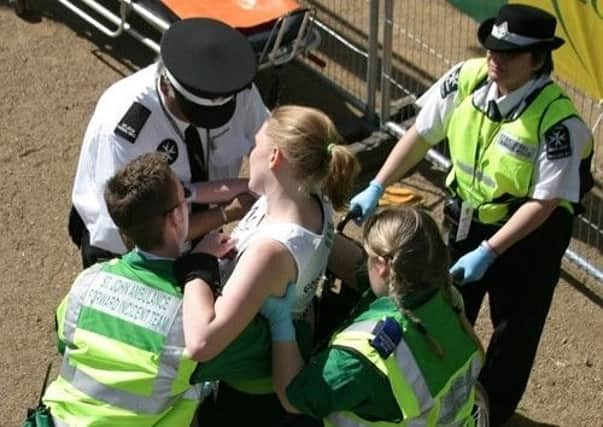ST JOHN AMBULANCE: First aid advice as temperatures soar


Heat exhaustion and heat stroke are the most serious problems that can develop when the mercury soars so it’s essential that people can spot the signs, such as headache and dizziness, and get them somewhere cool and rehydrated as soon as possible.
Apply sun cream, cover up and stay hydrated, as you are then more likely to enjoy the high temperatures without incident.
Advertisement
Hide AdAdvertisement
Hide AdProlonged exposure to the sun or lack of fluids can cause your body to dangerously overheat. If someone is suffering from heatstroke they may have symptoms such as a bounding pulse, headache and dizziness. Their skin will be hot to the touch, red and flushed. As the condition worsens they will become disorientated and confused.
It’s important to lower their body temperature as soon as possible. To treat someone suffering from heatstroke, with their permission, remove as much of their clothing as possible and dial 999 for an ambulance. Move them to a cool place and wrap them in a cold, wet sheet or a suitable alternative until their temperature falls. If a sheet isn’t available, sponge them with cold water.
Once their temperature returns to normal replace the sheet with a dry one and make a note of their pulse and breathing until help arrives. If their temperature starts to rise again, repeat the cooling process.
Heat exhaustion is caused by the loss of salt and water from excessive sweating.
Advertisement
Hide AdAdvertisement
Hide AdCommon symptoms include headache, dizziness, cramps, breathing that is fast but weakening, and profuse sweating.
Take the person into a cool, shady area and make them as comfortable as possible.
Get them to lie down with their legs raised and give them plenty of water.
If you have them available, use isotonic drinks or a sachet of oral rehydration powder in water instead.
Advertisement
Hide AdAdvertisement
Hide AdDehydration happens when the fluid lost from the body – usually through sweat – isn’t replaced. Symptoms are a dry mouth and eyes, headaches, dark urine, dizziness and confusion. Avoid it by drinking water regularly, not just when you feel thirsty.
The young and old are at particular risk, so it’s crucial to rehydrate them promptly – and if you’re playing sports or other demanding activities, your fluid needs will be much higher.
To treat dehydration, drink plenty of fluids; water is normally suitable but you may prefer to add oral rehydration powder to help replace the salts lost from the body.
Fainting can be triggered by heat, so if you’re prone to fainting, ensure you eat regularly and don’t stand up for extended periods during the heatwave.
Advertisement
Hide AdAdvertisement
Hide AdIf someone feels faint, advise them to lie down, then raise their legs to improve blood flow to the brain. Make sure they have fresh air, and keep bystanders away if you can.
Watch their face for signs of recovery, and as they begin to recover, help them to sit up gradually.
Sunburn is one of the most common injuries that St John Ambulance volunteers see. Protect yourself by wearing sunscreen, protective clothing and staying in the shade, but if it’s happened already there are some simple ways to ease the pain. As soon as you notice, cover yourself up and move out of the sun.
Take frequent sips of cold water and cool the burnt skin with a cold damp cloth, or you may find it more practical to soak the area in a basin or bath of cool water for around ten minutes.
Advertisement
Hide AdAdvertisement
Hide AdCalamine or aftersun lotion can make you feel more comfortable.
If your skin is blistered, you should seek medical advice.
You’re more likely to get cramp in the heat as it’s often caused by sweating, dehydration or exercise.
The sharp onset of pain makes it alarming, but by carefully stretching and gently massaging the affected muscles it can quickly be brought under control.
If it’s in the foot, stand with your weight in the front of the foot to stretch the muscles. If it’s in the calf, straighten your knee and flex the foot upwards. If it’s in the front of the thigh, raise the leg and bend the knee, and if it’s in the back of the thigh you should straighten the knee.
Massage the affected muscles afterwards.
Advertisement
Hide AdAdvertisement
Hide AdTo keep cool in the heat and stay safe, download the free St John Ambulance First Aid app for your iPhone or Android which gives advice on sunburn and heat stroke, as well as life saving information.
For more first aid advice for heat-related illnesses visit www.sja.org.uk
• For those looking for quick, easily accessible first aid information, the St John Ambulance app is available free on smartphones and the website offers demo videos, an interactive game, and lots of free advice. For more information about first aid courses please call 0303 003 0101.
---
Don’t miss out on all the latest breaking news where you live.
Advertisement
Hide AdAdvertisement
Hide AdHere are four ways you can be sure you’ll be amongst the first to know what’s going on.
1) Make our website your homepage
2) Like our Facebook page
3) Follow us on Twitter
4) Register with us by clicking on ‘sign in’ (top right corner). You can then receive our daily newsletter AND add your point of view to stories that you read here.
And do share with your family and friends - so they don’t miss out!
Always the first with your local news.
Be part of it.